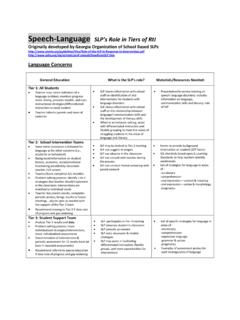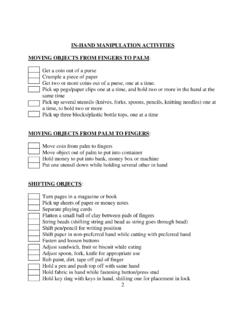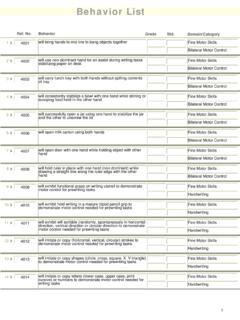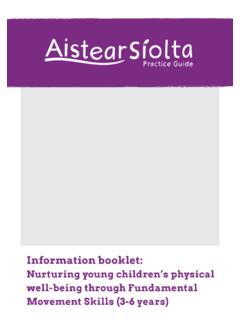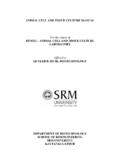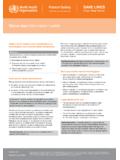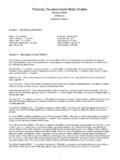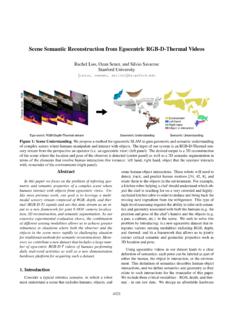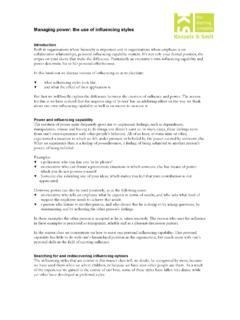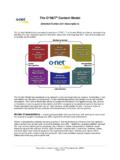Transcription of School Performance Checklist - Tri-County Special Education
1 School Performance Checklist Areas : Participation, Supports, and Performance The School Performance Checklist looks at a child s ability to function within the School environment in the areas of self-help, posture/ functional mobility, fine motor/ perceptual skills and sensory processing. Student Name: Date: : Grade: School : Parents Name: Phone: Referred By (circle): Parent Classroom Teacher SAT Person Completing Form: Indicate any diagnoses, medical concerns/precautions and/or Special considerations ( seizures, asthma, medications, etc.): Type of Classroom Current Services Regular Specialized Academic Instruction Special Education Speech/Language Therapy _____ Occupational and physical therapy in the public School setting is primarily concerned with the student's ability to function within the School environment.
2 The tasks contained in this Checklist are those that may typically be addressed by a School occupational therapist. Completion of this form is necessary so that the student assistance team and/or occupational therapist can identify interventions that can be implemented with general Education or to determine the need for a formal evaluation or continued services. Please complete this Checklist based on your daily observations of this student. You, as the classroom teacher, are most familiar with the student and any difficulties he or she may be experiencing in the School environment. _____ What are the specific concerns(examples of impact within daily activities)? _____ _____ _____ _____ Student Name:_____ SFC p.
3 2 Please use the following key when completing the Checklist that follows: [1] = A consistent problem (as compared to grade level peers) [2] = An infrequent problem (as compared to grade level peers) [3] = Not a problem (adequate skills or not applicable) I. SELF HELP SKILLS: The student's ability to manage personal needs within the educational environment. 1 2 3 Has difficulty taking off or putting on coat, boots, etc. 1 2 3 Has difficulty manipulating fasteners (buttons, snaps, zippers) 1 2 3 Has difficulty tying shoe laces 1 2 3 Requires assistance for hand washing 1 2 3 Has difficulty eating/drinking independently 1 2 3 Has difficulty opening food containers (milk carton, bags, etc.) 1 2 3 Has difficulty selecting and/or transporting food in cafeteria 1 2 3 Has difficulty transitioning between activities Comments: II.
4 POSTURE/FUNCTIONAL MOBILITY: The student's ability to perform basic developmental motor skills, posture, and balance needed to function in and move throughout the educational environment. A. Posture 1 2 3 Moves/fidgets excessively while at desk/table 1 2 3 Has difficulty maintaining posture at desk (slumps, head in hand, etc.) 1 2 3 Complains of or frequently appears fatigued 1 2 3 Has difficulty maintaining sitting position on floor B. Mobility 1 2 3 Has difficulty carrying School supplies/belongings in School environment 1 2 3 Trips or stumbles frequently 1 2 3 Has difficulty opening or closing doors 1 2 3 Moving in and out of vehicles, entering & exiting the building 1 2 3 Navigates and uses stairs/ramps inside and outside of the School building 1 2 3 Access and use of playground and PE equipment 1 2 3 Moves self form to and from positions (chair, floor, etc) 1 2 3 Moving in hallway, lining up, moving around obstacles Comments: Student Name:_____ SFC p.
5 3 [1] = A consistent problem (as compared to grade level peers) [2] = An infrequent problem (as compared to grade level peers) [3] = Not a problem (adequate skills or not applicable) III. FINE MOTOR/PERCEPTUAL SKILLS: The student's ability to manipulate and manage materials within the educational environment. A. Bilateral/Fine Manipulation Skills 1 2 3 Has difficulty cutting with scissors 1 2 3 Takes excessive amount of time/practice to learn new fine motor skills 1 2 3 Avoids/dislikes/appears to struggle with fine motor activities 1 2 3 Switches hands while writing, cutting, etc. 1 2 3 Has difficulty holding paper still while writing/drawing 1 2 3 Has difficulty using computer 1 2 3 Has difficulty using classroom tools: ruler, compass, stapler, etc.
6 1 2 3 Has difficulty with constructional tasks: art/science projects 1 2 3 Has difficulty manipulating small objects; frequently drops objects B. Handwriting/Printing (motoric aspect; not content, spelling, grammar, etc.) 1 2 3 Writing is frequently illegible 1 2 3 Forms letters poorly 1 2 3 Has difficulty writing on line 1 2 3 Letter/number size is inconsistent 1 2 3 Writing is excessively large 1 2 3 Writing is excessively small 1 2 3 Writing appears to require excessive effort/requires excessive time to write 1 2 3 Tends to press too hard on the pencil 1 2 3 Applies too little pressure on the pencil 1 2 3 Has difficulty spacing properly between words C. Visual Perceptual/Visual Motor 1 2 3 Has difficulty accurately copying information from books/papers 1 2 3 Has difficulty copying information from the board 1 2 3 Has difficulty aligning vertical columns; math problems, spelling lists 1 2 3 Has difficulty heading/setting up paper correctly 1 2 3 Frequently reverses letters/numbers 1 2 3 Is unable to recognize/identify shapes/letters/numbers 1 2 3 Has difficulty following directions involving terms such as up/down, left/right,etc.
7 Comments: Student Name:_____ SFC p. 4 Please use the following key when completing the Checklist that follows: [1] = A consistent problem (as compared to grade level peers) [2] = An infrequent problem (as compared to grade level peers) [3] = Not a problem (adequate skills or not applicable) IV. SENSORY PROCESSING: The student's ability to process relevant sensory information and screen out irrelevant sensory information for effective participation within the educational environment. A. Tactile Processing 1 2 3 Has difficulty tolerating touch or other children in close proximity, in line, at circle time, during group work. 1 2 3 Appears to dislike getting hands messy (art, glue, water, etc.) 1 2 3 Has difficulty keeping hands to self in line, group activities 1 2 3 Touches things/people constantly B.
8 Movement/Vestibular Processing 1 2 3 Appears hesitant/afraid of movement activities 1 2 3 Appears to be in constant motion; unable to sit still for an activity 1 2 3 Seeks quantities of movement ( swinging, spinning, bouncing, and jumping) C. Body Awareness/Proprioceptive Processing 1 2 3 Has difficulty negotiating through the School environment without bumping into others, knocking objects off desks, etc. 1 2 3 Has difficulty respecting the personal space/boundaries of others, positions self too close to others, leans on others 1 2 3 Appears to lack safety awareness/judgment 1 2 3 Seeks quantities of jumping/crashing, hanging on people or furniture, deep pressure, runs or bumps into walls/doors/people D. Auditory Processing 1 2 3 Appears overly sensitive to loud noises ( bells, toilet flush) 1 2 3 Becomes distressed during assemblies, lunch or other large gatherings 1 2 3 Covers ears to protect them from sound 1 2 3 Is distracted or has trouble functioning if there is a lot of noise The Student Assistance Team/PT/OT recommends Suggested interventions, accommodations and materials to be implemented within general Education to address areas of weakness.
9 (see attached) Further evaluation to complete a more in-depth assessment of student skills and Performance
